Brilliant budget friendly filters.
ToupTek Astro 36mm LRGB + SHO Filter Review.
Introduction.
We all know how expensive astronomy can be. Further to that, we all know how expensive astrophotography can be!!
When making the decision to move back to mono imaging early late last year, I first tested the waters, buying an old, used mono camera with LRGB and SHO filters. After making only a couple of images I was 100% sure this was the way I wanted to go. So the hunt was on for a good camera setup. The dilemma was, I didn’t want a smaller sensor than my colour camera (IMX294), so the IMX533 was out - and it pretty much had to be the IMX571.
I settled on the Touptek ATR2600M, with the 7x36mm AFW-M and the M54 OAG-L. I hadn’t settled on filters yet…I figured ‘I had astrodon filters in my KAF8300.. I’ll just find a set of those for sale somewhere.’
Yeah… Firstly, I couldn’t find a set for sale locally or internationally, and the prices these days for a used set of Astrodon 36mm LRGBSHO filters is UNBELIEVABLE... It would almost cost me more than the entire camera setup. So I began looking at other options.
I wanted to avoid anything with strong halos or reflections, as my processing skills are certainly not as good as my data acquisition skills are… the last thing I want is to make my image processing harder. A number of brands were ruled out based on halo issues, internal reflection issues etc, and a couple more due them being more expensive than the camera, and in one case, almost more expensive than the rest of my imaging rig.
I noticed that ToupTek had a full 36mm filter set available on their website - though I could not find any reviews or sample images to see how they performed.
ToupTek Astro 36mm LRGB Filters
ToupTek Astro 36mm SHO Filters
I reached out to ToupTek Astro and they agreed to send me a set of the 36mm LRGB and the 36mm SHO filters to review.
Specs.
As for the specifications of these filters, what we’re looking at is a set of 36mm unmounted filters, the filters are blackened around the edges to help with preventing any unwanted reflections from off-axis light. They are all treated with an anti-reflection and scratch resistant coating.
Bandpasses:
These are all claimed values, and I do not presently have any way to confirm these.
L: 420nm to 685nm (Effectively, a UV/IR cut filter as expected)
R 590nm - 710nm (Encompasses Ha and SII)
G 490nm - 580nm (Cuts out mercury and sodium but encompasses OIII)
B 400nm - 510nm (Encompasses Hb and OIII)
SII 4.5nm fwhm at 671.6nm
Ha: 3.5nm fwhm at 656.3nm
OIII 4.5nm fwhm at 500.7nm
The narrowband filters have an Optical Density as high as 5.0, which can help to block other interfering light almost entirely.
Parfocality:
In my first night with the filters, I spent a bit of time calculating the filter focus offsets. This would make further tests much more expedient, but also give some good indications of the overall parfocality of the filter set.
With this part - if I am to be completely fair - I can’t be 100% sure there was not some thin cloud obscuring the offset calculations that were being run via NINA’s ‘Offset Calculator’ plugin… I have not had very clear weather in a long time.
With that caveat out of the way, I’ll start by saying, no set of filters I’ve ever used (Astrodon, Astronomik Type 2c and Baader etc.) have ever been truly parfocal. The ToupTek LRGB filters are close, with only a 8 step difference between the L and Blue filters, and a 4 step difference between B and G. You would probably get away with doing an imaging run with them without refocusing on my F/7 optical system. Focus adjustments between almost all filter changes is recommended and on faster optical systems, it would likely be 100% necessary.
The narrowband filters are another story. I calculated 15 focuser steps between the SII and the Ha filter. This is very close, however, not unexpected considering how close they are in wavelength. OIII however, is about 55 steps further in from Ha, which is a massive shift. So far in fact, that if I am focused in Ha, then try to initiate an autofocus run for OIII, the first attempt will be off the mark and I will have to run a subsequent autofocus run to get it right. Once focus offsets are calculated correctly, that ceases to be an issue
So, are they parfocal? No. Does it matter? Also no.
You will definitely want an autofocusing system like the ToupTek AAF to ensure that this is taken care of for you automatically during imaging runs..
For reference, these are the offsets I’ve recorded through a number of test runs.
I focus using the L filter, so we’ll consider its position as ‘0’.
L : Offset = 0 (I autofocus in L, so L requires 0 offset to be in focus).
R : Offset = +15
G : Offset = +12
B : Offset = +8
S : Offset = +30
H : Offset = +45
O : Offset = -10
Image Tests.
I wanted to make my first few images with these filters by creating a straight LRGB image, a HOO and SHO image, and then hopefully, a HaOIIILRGB image. Unfortunately, since I received the filters, the weather here has been horrible (to the extent of having over 10 straight days of rain due to a Tropical Cyclone). Thus, my testing has been far more limited than I would have originally liked.
Image 1: IC447 in LRGB:
Shot over 3 nights from my Bortle 5 back yard, this image was my first LRGB image in quite some time.
I accumulated a total of 9h 20m of integration:
115x180s Lum (Bin 1x1)
30x120s R (Bin 2x2)
30x120s G (Bin 2x2)
40x120s B (Bin 2x2)
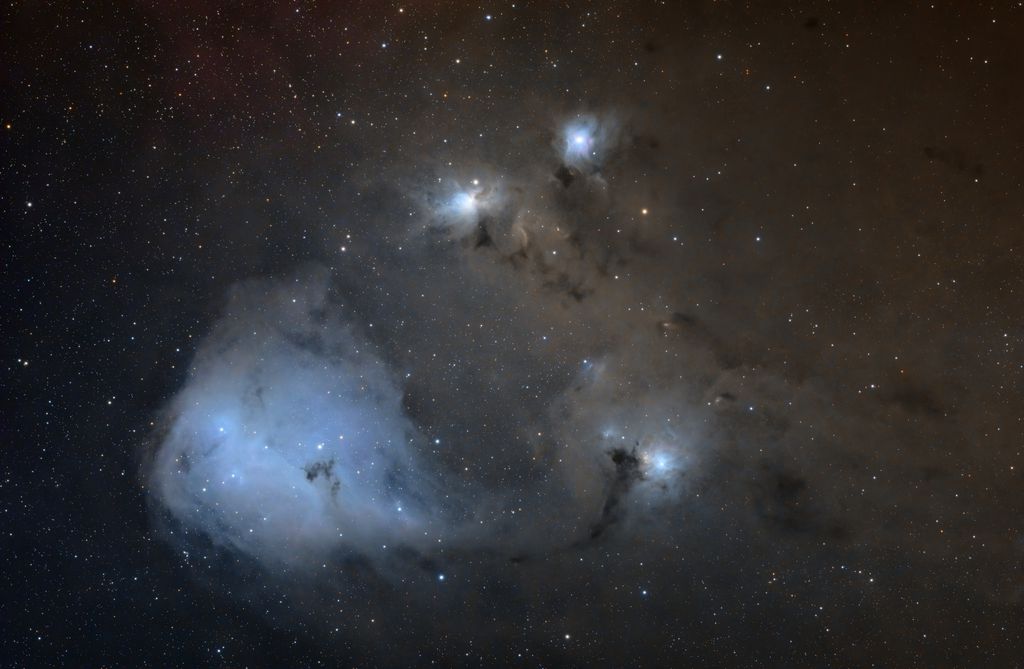
https://www.astrobin.com/oeejao/B/
Aside from being initially blown away by the ATR2600M’s incredible performance and low noise, I noticed that the RGB when combined were almost perfectly colour balanced, and colour calibration did not have to make too many changes to bring the image to perfect colour correction.
Image 2: NGC2599 in SHO:
A couple of weeks worth of rain and cloudy nights passed before I was able to get out and test the narrowband filters.. This time, I chose to focus on the Gabriela Mistral nebula, with some of the surrounding area of Eta Carina in the frame too. I had planned to get around 3h per channel, however, The sky was only clear enough for me to get a total of 3h 40m integration on this target.
I collected just 3h 40m of data on this image:
12x600s Ha
5x600s SII
5x600s OIII
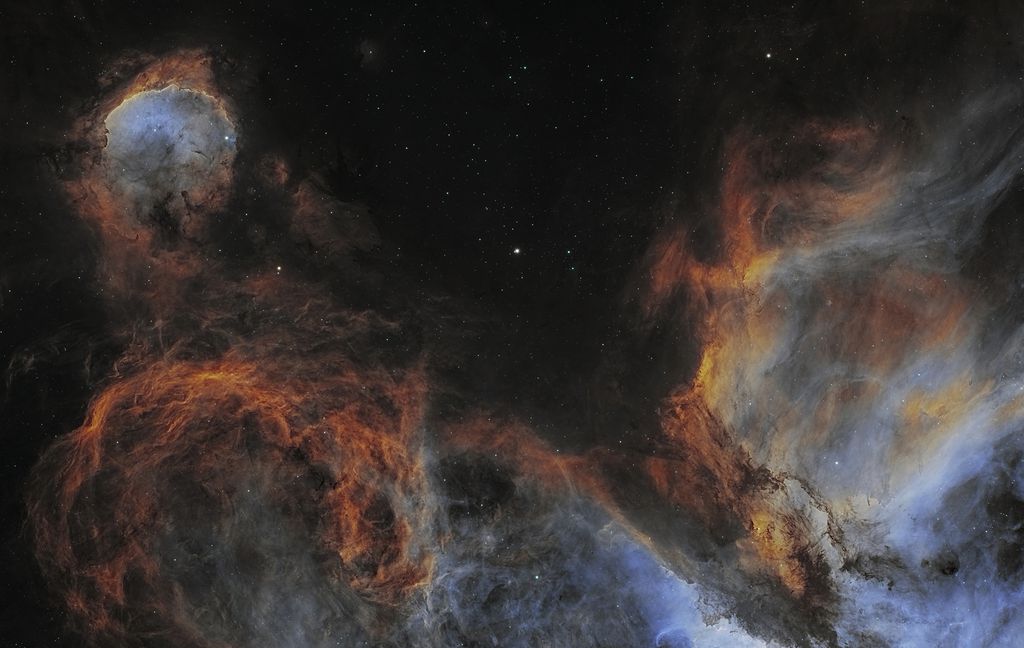
https://www.astrobin.com/oqq3xe/C/
The result here was quite amazing. The sharpness and detail provided by the ToupTek SHO filter set is amazing.. I achieved a 1.53 FWHM in the 2nd night of Ha data - which is incredibly sharp for this location. Achieving a pleasing colour balance with this image was quite straight forward, indicating a nice balance in the signal levels from each filter.
Image 3: NGC2736 in HOO:
For the next test, I really wanted to image a target that is bright, but has plenty of faint details, but is also hidden in light pollution from my location.
While narrowband filters are not a 100% cure for light pollution, they do a pretty amazing job on the right types of targets in light polluted conditions. Pointing at zenith, my backyard is a bortle 4 zone, however, when I point a sky quality meter towards the south, I am contending with bortle 5 to bortle 6 levels of light pollution…
I selected this target, The Pencil nebula, which is a small outer detail of the larger Vela Supernova Remnant. The area contains no SII to speak of, so I focused my time on Ha and OIII. What was surprising here was that the Ha signal was quite weak, however the ToupTek filters were able to pull very faint structures out through the light pollution in only a relatively short integration time of 4h 20min.
The dataset consists of:
28x300s Ha
24x300s OIII
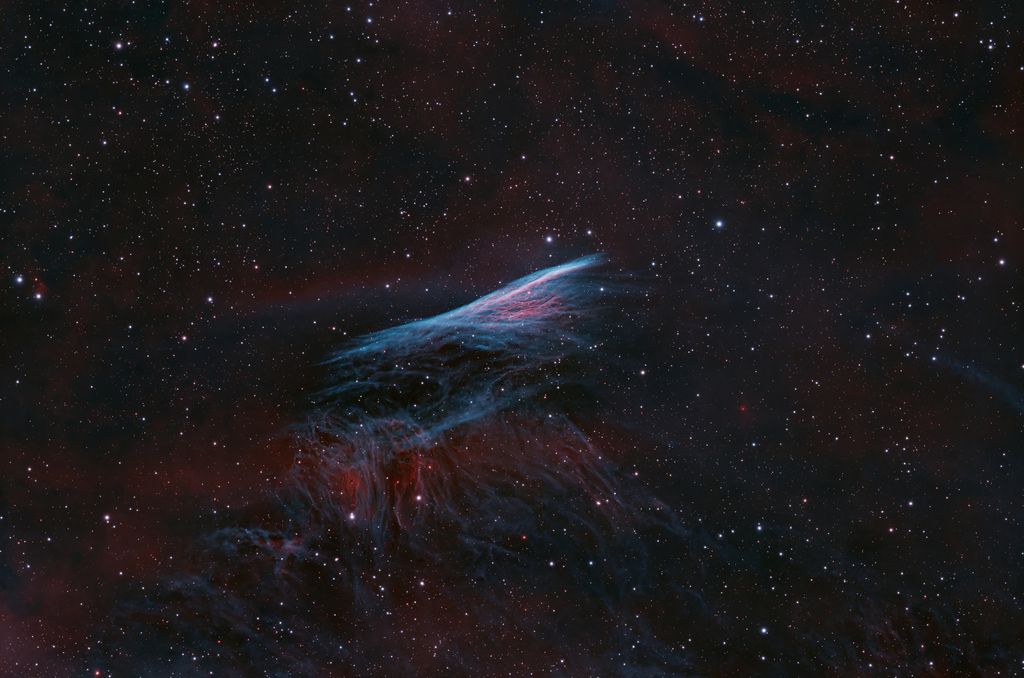
https://www.astrobin.com/ab1yz6/C/
The OIII signal is beautifully sharp, has a lot of detail and is fantastically vibrant against the subtle hints of Ha in the background, resulting in a very high contrast image that was VERY easy to process.
Image 4: NGC2944 in SHO:
Again - I had a 2 week period of cloud and rain prior to being able to produce the next image - another SHO image this time - The Running Chicken Nebula.
IC2944 is a stunning target with lots of interesting details, however the real difficulty of this target is dealing with the extreme contrast of its brightest details and the fainter, more wispy areas of nebulosity - but also, from Lambda Centauri, the bright star in the top right of frame.
Lambda Centauri is a magnitude 3.3 star, which sure, it’s not Alnitak, but it poses the same sort of problems that Alnitak would normally pose, being that it is a very bright star, that is surrounded by faint nebulosity. Attempts to extract the most from the surrounding nebulosity will usually result in halos becoming very pronounced if they occurred.
This was actually the shortest dataset in the test, I did not get much time at all before clouds came back.
The data set consists of only 1h 30m integration:
3x600s Ha
3x600s SII
3x600s OIII
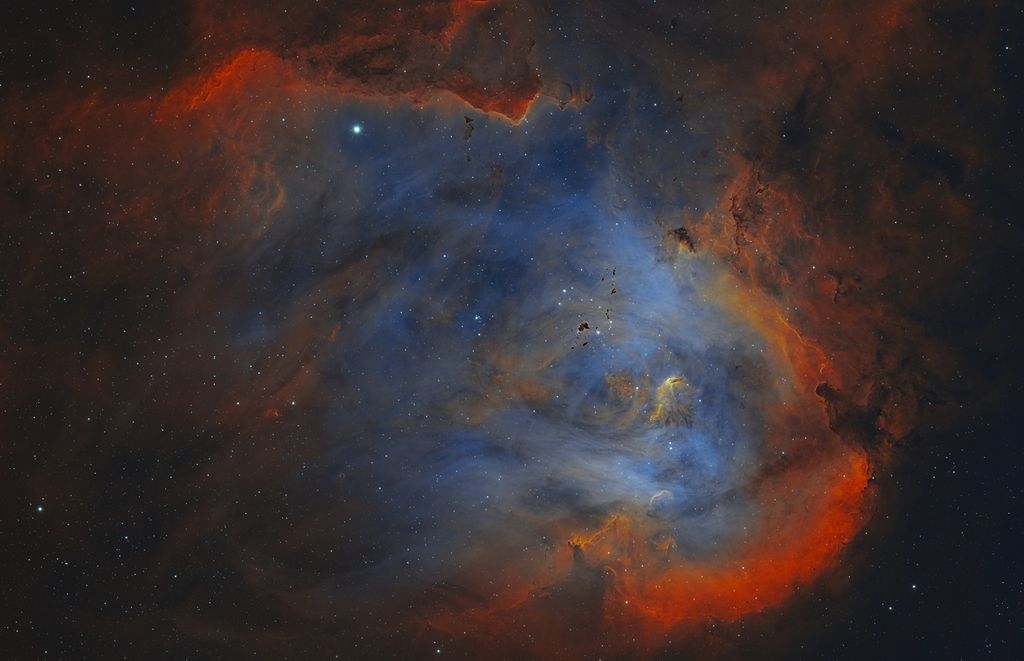
https://www.astrobin.com/5cfk5i/B/
Again - the detail that was extracted by the ToupTek narrowband filters is amazing, and the overall colour balance of the image was easy to achieve.
And here is the OIII raw stack with no processing further than an aggressive screen stretch, cropped to show the result around Lambda Centauri. As you can see, there is a very small, tight halo here around Lambda Centauri, however, in the final image, I was able to completely mitigate that by stretching the stars separately from the nebulosity, and in the final image, it can not be seen at all.
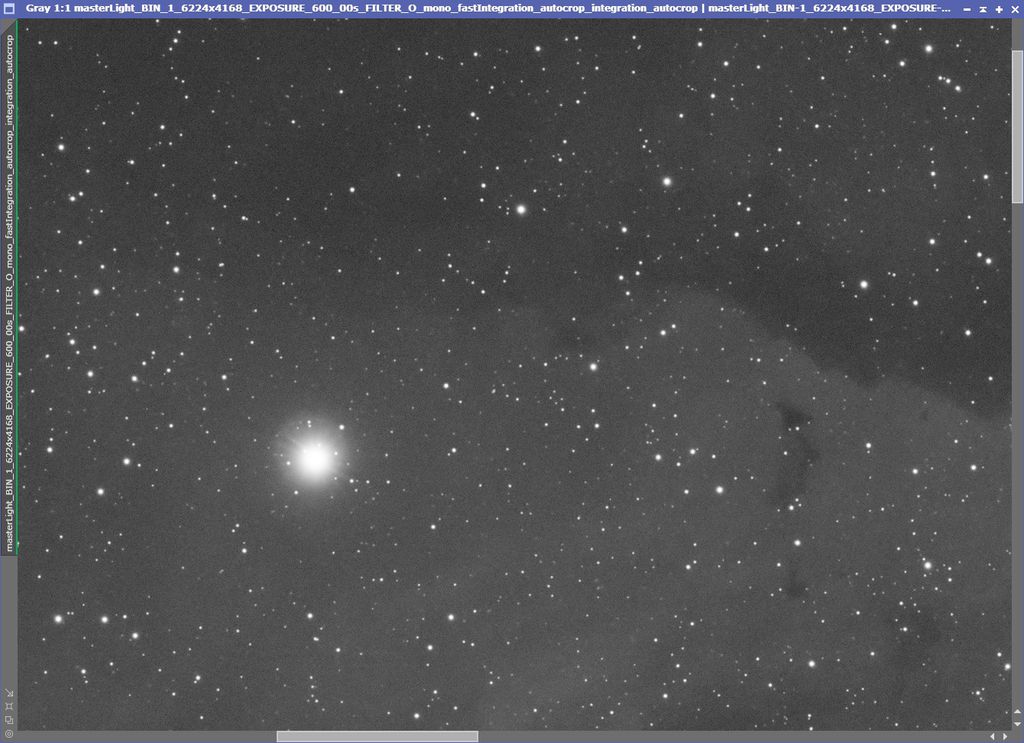
Conclusions:
To put my thoughts into the simplest possible terms, for the price, the ToupTek Astro 36mm LRGB and SHO filters are brilliant.
I have not experienced any situations yet where I feel like spending more money on filters would provide me with better images. I’ve suffered no objectionable halos around bright stars with any of the 7 filters - which in my opinion, is an incredible result in itself. Further to that, its well understood that an OIII filter is one of the hardest to produce in good quality, which was the exact reason behind me wanting to focus on both a predominantly OIII target like the pencil nebula, and also a target where a very bright star appears within some faint OIII gas. In both situations, the OIII filter did an incredible job of capturing the faintest, finest details, whilst also handling one of the brightest, most difficult stars in a southern hemisphere target. A Chroma OIII filter may not have had any halo at all, but a 36mm Chroma OIII also costs over 3x what this full set of 7 filters costs…
In my opinion, this result is MORE than acceptable, and in fact, when compared to more expensive filters I’ve used from Baader, and results I’ve seen from other more expensive brands, this result is VERY impressive.
Parfocality is one of those things with filters that gets either completely overlooked, or a manufacturer will claim that their filters are parfocal, but in reality, they never are. With modern cameras that have very small pixels, and optical systems that are exceptionally fast, I don’t think any filters are going to be 100% parfocal. ToupTek Astro certainly does not claim that their filters are parfocal, and in my opinion, that is perfectly fine.
Verdict:
I find that generally, people have similar requirements when they buy filters. They want them to be well balanced and able to create faithful images of the night sky, and they want them to do so without optical aberrations… Unfortunately, to get both these two requirements, the prices can be, pardon the pun, astronomical…
ToupTek Astro have really delivered here, with a solid set of LRGB filters, matched with a BRILLIANT set of narrowband filters that perform wonderfully, at a price that really can’t be ignored. I honestly think you would have a very hard time finding better filters anywhere near to this price point!
Links:
ToupTek Astro 36mm LRGB Filters
ToupTek Astro 36mm SHO Filters
ToupTek Astro
Alex Nicholas.


